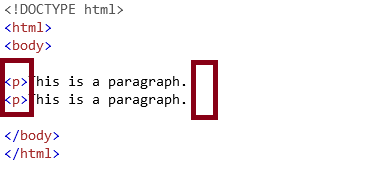Tips (Total 5)
# Tips-1) What is HTML Elements
An HTML element is a type of HTML document component, one of several types of HTML nodes. The first used version of HTML was written by Tim Berners-Lee in 1993 and there have since been many versions of HTML. The most commonly used version is HTML 4.01, which became official standard in December 1999.
The HTML element is everything from the start tag to the end tag:
<tagname>Content goes here...</tagname>
Examples of some HTML elements:
<h1>My First Heading</h1>
<p>My first paragraph.</p>
| Start tag | Element content | End tag |
|---|---|---|
| <h1> | My First Heading | </h1> |
| <p> | My first paragraph. | </p> |
| <br> | none | none |
Note: Some HTML elements have no content (like the <br> element). These elements are called empty elements. Empty elements do not have an end tag!
Example of HTML Elements
Examples of some HTML elements:
<h1>My First Heading</h1>
Examples of some HTML elements:
<p>My first paragraph.</p>
# Tips-2) What is Nested HTML Elements
HTML elements can be nested (this means that elements can contain other elements).
All HTML documents consist of nested HTML elements.
The following example contains four HTML elements (<html>, <body>, <h1> and <p>):
HTML elements may contain other elements. This is called nesting, and to do it properly, the entire element (including its markup) must be within the start and end tags of the containing element (the parent). Proper nesting is one of the criteria of a well-formed document (a requirement for XHTML).
Example of Nested HTML Elements
<h1>My First Heading</h1>
<p>My first paragraph.</p>
Example of Full Page Nested Element
index.html
Example:
HTML
<!DOCTYPE html>
<html>
<body>
<h1>My First Heading</h1>
<p>My first paragraph.</p>
</body>
</html>
Output should be:

Example Explained
The <html> element is the root element and it defines the whole HTML document. It has a start tag <html> and an end tag </html>. Then, inside the <html> element there is a <body> element:
<body>
<h1>My First Heading</h1>
<p>My first paragraph.</p>
</body>
The <body> element defines the document's body. It has a start tag <body> and an end tag </body>. Then, inside the <body> element there are two other elements: <h1> and <p>:
<h1>My First Heading</h1>
<p>My first paragraph.</p>
The <h1> element defines a heading. It has a start tag <h1> and an end tag </h1>:
<h1>My First Heading</h1>
The <p> element defines a paragraph. It has a start tag <p> and an end tag </p>:
<p>My first paragraph.</p>
# Tips-3) Why should Never Skip the End Tag HTML Elements
Some HTML elements will display correctly, even if you forget the end tag:
Example of End Tag
Every Title should combine with tag. Like: <p>WWE</p> . We recommend not use likely: <P>WWE
index.html
Example:
HTML
<!DOCTYPE html>
<html>
<body>
<p>This is a paragraph.
<p>This is a paragraph.
</body>
</html>
Output should be:

Correct uses Tags
Example given following a correct way uses Tag
index.html
Example:
HTML
<!DOCTYPE html>
<html>
<body>
<p>This is a paragraph.</p>
<p>This is a paragraph.</p>
</body>
</html>
Output should be:

What may happen if you never use end Tag?
If you do not use end Tag. It may cause affected other Elements.
# Tips-4) What is Empty HTML Elements
HTML elements with no content are called empty elements.
The <br> tag defines a line break, and is an empty element without a closing tag:
Example of Empty HTML Elements
<p>This is a <br> paragraph with a line break.</p>
index.html
Example:
HTML
<!DOCTYPE html>
<html>
<body>
<p>This is a <br> paragraph with a line break.</p>
</body>
</html>
Output should be:

# Tips-5) Why HTML is Not Case Sensitive
HTML tags are not case sensitive: <P> means the same as <p>.
The HTML standard does not require lowercase tags, but W3C recommends lowercase in HTML, and demands lowercase for stricter document types like XHTML.
At ITupto we always use lowercase tag names.